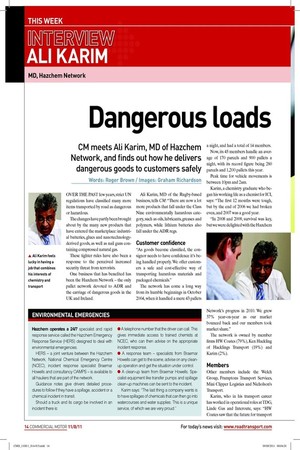Dangerous loads
Page 12

Page 13

If you've noticed an error in this article please click here to report it so we can fix it.
CM meets Ali Karim, MD of Hazchem Network, and finds out how he delivers dangerous goods to customers safely
Words: Roger Brown / Images: Graham Richardson
OVER THE PAST few years, strict UN regulations have classiied many more items transported by road as dangerous or hazardous.
The changes have partly been brought about by the many new products that have entered the marketplace: industrial batteries, glues and nanotechnologyderived goods, as well as nail guns containing compressed natural gas.
These tighter rules have also been a response to the perceived increased security threat from terrorists.
One business that has beneited has been the Hazchem Network – the only pallet network devoted to ADR and the carriage of dangerous goods in the UK and Ireland.
Ali Karim, MD of the Rugby-based business, tells CM: “There are now a lot more products that fall under the Class Nine environmentally hazardous category, such as oils, lubricants, greases and polymers, while lithium batteries also fall under the ADR regs.
Customer confidence
“As goods become classiied, the consignor needs to have conidence it’s being handled properly. We offer customers a safe and cost-effective way of transporting hazardous materials and packaged chemicals.” The network has come a long way from its humble beginnings in October 2004, when it handled a mere 43 pallets a night, and had a total of 14 members.
Now, its 45 members handle an average of 170 parcels and 900 pallets a night, with its record igure being 260 parcels and 1,200 pallets this year.
Peak time for vehicle movements is between 10pm and 2am.
Karim, a chemistry graduate who began his working life as a chemist for ICI, says: “The irst 12 months were tough, but by the end of 2006 we had broken even, and 2007 was a good year.
“In 2008 and 2009, survival was key, but we were delighted with the Hazchem Network’s progress in 2010. We grew 37% year-on-year as our market bounced back and our members took market share.” The network is owned by member irms HW Coates (79%), Ken Hackling of Hacklings Transport (19%) and Karim (2%).
Members
Other members include the Welch Group, Framptons Transport Services, Mini Clipper Logistics and Nicholson’s Transport.
Karim, who in his transport career has worked in operational roles at TDG, Linde Gas and Interoute, says: “HW Coates saw that the future for transport is in collaborative working and invested in the ADR pallet network concept. Working in partnership is the only way to do things these days, as the cost of fuel for hauliers is crippling.
“Palletised ADR has also grown because customers do not want to store a lot of chemicals on site,” says Karim.
The well-ventilated, 56,000ft2 depot – a former tyre warehouse – is segregated by chemical class into quadrants. There are CCTV cameras, two foam cannons, emergency rooms, safety showers, oil interceptors out in the yard and a high door to provide access for double-deck trailers.
Full audit
The Hazchem Network carries out a full audit on new members and, according to Karim, is fastidious on matters of regulatory compliance.
He believes ADR work attracts a better standard of haulier, as businesses have to take extreme care in this niche area.
“If your company supplies dangerous goods, you are probably already taking steps to operate safely – from careful storage in the warehouse to ensuring that your staff are suitably trained,” Karim adds.
Depot staff are given ire and chemical protection training. The company works closely with the likes of the Department for Transport, the Health and Safety Executive and VOSA, as well as Warwickshire Fire and Rescue Service, the Highways Agency and the police, as it works to continually improve and update its procedures.
Karim concludes: “Our balance sheet remains rock solid, and we continue to plough proits back into increased marketing support, our HERS project [see box], and the hazardous parcel service [see box].
“Chemistry has always been a passion for me. I got my irst chemistry set when I was 12 years old and that irst sparked my interest in science. Transport has also become a passion of mine over the years, and I consider myself very lucky to be able to combine my interests like this.” ■














































